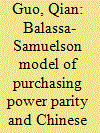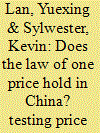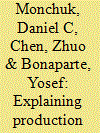|
|
|
Sort Order |
|
|
|
Items / Page
|
|
|
|
|
|
|
| Srl | Item |
| 1 |
ID:
095936


|
|
|
|
|
| Publication |
2010.
|
| Summary/Abstract |
Our principal purpose here is to assess the extent to which both the official and black market exchange rates for the Chinese economy exhibit compatibility with the Balassa-Samuelson model over the period from 1985 to 2006. We employ annual measures of inflation and industry input on an aggregated, disaggregated and sector basis, all of which have been especially constructed for this study. Both the time series and panel cointegration tests applied to this data are generally inconsistent with the prediction of the Balassa-Samuelson model that the tradable goods sector is compatible with purchasing power parity. However, our analysis also shows that other predictions of the Balassa-Samuelson model - most notably that there will be a strong long-run relationship between the real exchange rate and the relative productivity differential between China and the U.S. - does hold up for the Chinese economy. Moreover, the black market exchange rate appears to be more consistent with the predictions of the Balassa-Samuelson model than the official exchange rate.
|
|
|
|
|
|
|
|
|
|
|
|
|
|
|
|
| 2 |
ID:
095935


|
|
|
|
|
| Publication |
2010.
|
| Summary/Abstract |
The existing literature that discusses China's macroeconomic volatility during the reform period does so with overwhelming reference to the business cycle. However, the business cycle is only a subset of macroeconomic volatility that occurs within a particular frequency band. In this paper we decompose various macroeconomic series by frequency and find that much volatility occurs at lower than business cycle frequencies. This suggests that it is necessary to look beyond the construct of the business cycle in order to understand the nature of China's macroeconomic volatility, and beyond the usual demand side explanations in the discussion of causes.
|
|
|
|
|
|
|
|
|
|
|
|
|
|
|
|
| 3 |
ID:
095932


|
|
|
|
|
| Publication |
2010.
|
| Summary/Abstract |
China's collectively-owned enterprises are unconventional, as they are nominally owned by those people residing in the areas where the enterprises are located but effectively controlled by the local governments. This study finds that collectively-owned enterprises, once being privatized, encounter an increase in the cost of goods sold to sales ratio but manage to lower down the managerial expenses to sales ratio. The findings imply that local government officials may help collectively-owned enterprises gain access to cheaper production inputs, but they may use those enterprises to pursue private benefits, thereby shedding lights on the costs and benefits of government control.
|
|
|
|
|
|
|
|
|
|
|
|
|
|
|
|
| 4 |
ID:
095928


|
|
|
|
|
| Publication |
2010.
|
| Summary/Abstract |
This study examines to what extent prices diverge across China and how long it takes prices to converge following idiosyncratic shocks. We consider monthly data using disaggregated goods prices from 36 cities in China. Following [Imbs, J., Mumtaz, H., Ravn, M., and Rey, H., 2005. PPP strikes back: aggregation and the real exchange rate. Quarterly Journal of Economics 120, 1-44.], we use two estimation methods: a fixed effect method when considering goods individually and a mean group estimation specification for a panel including all goods simultaneously. The mean group method also accounts for dynamic heterogeneity across goods. Impulse response functions are obtained to calculate half-lives. With both methods, we find half-lives of only a few months or less, supporting the conjecture that convergence rates within a country are faster than rates estimated in an international context. However, the half-life reported here is still shorter than that for other studies using disaggregated intracountry data. Perhaps a lower degree of specialization and market differentiation in developing countries creates a greater potential for price convergence.
|
|
|
|
|
|
|
|
|
|
|
|
|
|
|
|
| 5 |
ID:
095937


|
|
|
|
|
| Publication |
2010.
|
| Summary/Abstract |
In this paper we examine more closely the factors associated with production inefficiency in China's agriculture. The approach we take involves a two-stage process where output efficiency scores are first estimated using data envelopment analysis, and then in the second stage, variation in the resulting efficiency scores is explained using a truncated regression model with inference based on a semi-parametric bootstrap routine. Among the results we find that a heavy industrial presence is associated with reduced agricultural production efficiency and may be an indication that externalities from the industrial process, such as air and ground water pollution, affect agricultural production. We also find evidence that counties with a large percentage of the rural labor force engaged in agriculture tend to be less efficient, and suggests that nurturing and promoting growth of non-primary agriculture may lead to more efficient use of labor resources in agriculture.
|
|
|
|
|
|
|
|
|
|
|
|
|
|
|
|
| 6 |
ID:
095938


|
|
|
|
|
| Publication |
2010.
|
| Summary/Abstract |
In this study we apply a random utility modeling framework to analyze housing demand in the city of Shanghai. A Multinomial Logit Model taking account of latent choice sets is employed to investigate the impact of household characteristics, such as income, size and age composition, on the choice of dwelling, specified by location, size and unit price. In addition to the price and income effects on housing demand, the model identifies a quality indicator for dwelling attributes, which can be interpreted as the mean attractiveness in a money metric measure.
The data used in this study are cross-sectional survey data. The estimated model is used to calculate demand elasticities and demand probabilities, for selected groups of households and types of dwellings. Among the results can be noted that the price-income ratios, the age composition and size of household are all important determinants of the demand. The impact of income distribution on housing demand is also studied.
|
|
|
|
|
|
|
|
|
|
|
|
|
|
|
|
| 7 |
ID:
095930


|
|
|
|
|
| Publication |
2010.
|
| Summary/Abstract |
The central themes to be addressed during the Doha Round of the world trade negotiations are the reduction of the agricultural production and export subsidies and improved market access for agricultural and non-agricultural goods. The G-20 group wields enough power to press negotiations at the Doha Round toward lower agricultural trade barriers and production and export subsidies. The objective of this study is to determine the impacts of the Doha Round on the economies of Brazil, China, and India. The Global Trade Analysis Project's (GTAP) general equilibrium model and database (version 7) are used. The Doha Round scenarios simulated in this paper consider the WTO agricultural production and export subsidy reduction requirement, and the application of the Harbinson approach, and Swiss formula to reduce import tariffs. Brazil and China present the highest GDP growth rate varying from 0.4 % to 1.4%. India shows a negative GDP growth rate in all scenarios, except in that which replicates the Uruguay Round. The welfare gains are positive, but small, for Brazil, China and India. The GDP loss observed in the economies of the EU25 and the US may make it difficult to reach a trade agreement at the Doha Round.
|
|
|
|
|
|
|
|
|
|
|
|
|
|
|
|
| 8 |
ID:
095929


|
|
|
|
|
| Publication |
2010.
|
| Summary/Abstract |
We model provincial inflation in China during the reform period. In particular, we are interested in the ability of the hybrid New Keynesian Phillips Curve (NKPC) to capture the inflation process at the provincial level. The study highlights differences in inflation formation and shows that the NKPC provides a reasonable description of the inflation process only for the coastal provinces. A probit analysis suggests that the forward-looking inflation component and the output gap are important inflation drivers in provinces that have advanced most in marketisation of the economy and have most likely experienced excess demand pressures. These results have implications for the relative effectiveness of monetary policy across the Chinese provinces.
|
|
|
|
|
|
|
|
|
|
|
|
|
|
|
|
| 9 |
ID:
095933


|
|
|
|
|
| Publication |
2010.
|
| Summary/Abstract |
There are many empirical studies trying to test if there is income convergence across the provinces of China. In this paper, we bring new information to the current literature by applying non-linear panel unit root test of Exponential Smooth Auto-Regressive Augmented Dickey-Fuller (ESTAR-ADF) unit root test developed by Cerrato et al. (2008) to the time series data for the period 1952-2003. The number of converging provinces decreases in the post-reform period when using panel ESTAR-ADF test. Furthermore, our results find evidence of increasing regional disparity that has been prevailing in China since the open door economic reforms of the late 1970s, which confirms the view of Pedroni and Yao (2006) that interprovincial inequalities have been widening since 1978.
In addition, we also examine the determinants of conditional convergence in China. The results indicate that low inflation, transport and telecommunication infrastructure, and trade openness could stimulate economic growth in China. Human capital also play a significant role in growth, and it exhibits non-linearity between human capital and growth in the sense that at low levels of human capital the effect on growth is negative and became positive at middle levels.
|
|
|
|
|
|
|
|
|
|
|
|
|
|
|
|
| 10 |
ID:
095931


|
|
|
|
|
| Publication |
2010.
|
| Summary/Abstract |
This paper studies the substitution effect of permanent land-use rights on endowment insurance in China. We first explain the rationality using an overlapping-generations model with heterogeneous households possessing land-use rights or not, and find that economic agents profiting from land in the latter stage of their life tend to save less for retirement than their land-deprived counterparts. Empirical evidence from village-clustered Chinese survey data on rural households supports this finding, locating a significant negative effect of land on social and commercial endowment insurance purchase. Apart from the important policy implication of compensating land-deprived farmers with insurance, our theoretical and empirical models both yield unexpected informing findings.
|
|
|
|
|
|
|
|
|
|
|
|
|
|
|
|
| 11 |
ID:
095934


|
|
|
|
|
| Publication |
2010.
|
| Summary/Abstract |
This article investigates tunneling by controlling shareholders in China's public companies, and finds that, first, tunneling is pervasive and severe; and, second, private controlling ownership significantly increases the severity of tunneling. This article argues that in China, where there is not sufficient and effective legal protection for investors, controlling shareholders, especially shareholders of privately controlled public companies, are able to conduct tunneling at minimal costs. Further, corporate governance mechanisms alone are not sufficient to protect minority shareholders.
|
|
|
|
|
|
|
|
|
|
|
|
|
|
|
|
| 12 |
ID:
095927


|
|
|
|
|
| Publication |
2010.
|
| Summary/Abstract |
A newly emerging area in international economics looks at the cross-correlation coefficient between past and future values of the trade balance and movement in the current exchange rate as a way of analyzing the response of the trade balance to exchange rate changes. Since the cross-correlation function follows a symmetric pattern, it comes under the heading of the S-Curve. Previous studies have considered the experience of developed and developing countries with the S-Curve, excluding China. In this paper we consider the Chinese experience. We show that when aggregate trade data between China and the U.S. are considered, there is no evidence of the S-Curve. However, when the data are disaggregated by commodity, the S-Curve is supported in almost 50% of the close to 100 industries considered. Furthermore, it appears that commodity types do not have any influence in determining the existence of an S-Curve pattern.
|
|
|
|
|
|
|
|
|
|
|
|
|
|
|
|
|
|
|
|
|